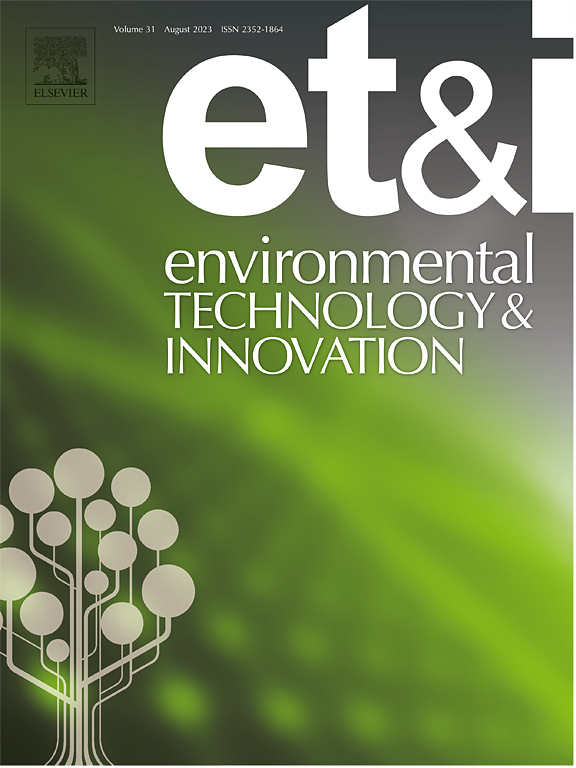Green strategies for chromium detoxification in tannery effluents: Adsorption and bioconversion with Portieria hornemannii
IF 6.7
2区 环境科学与生态学
Q1 BIOTECHNOLOGY & APPLIED MICROBIOLOGY
引用次数: 0
Abstract
Hexavalent chromium (Cr (VI)) is a toxic heavy metal contaminant that poses significant risks to living organisms. Notably, the red algae Portieria hornemannii has demonstrated the ability to adsorb and reduce chromium in aqueous environments. This study focuses on the effective on-site adsorption and bioconversion of Cr (VI) to Cr (III) using organized dead algal biomass enriched with active phytochemicals. The biomass's structural characteristics, surface morphology, functional groups, elemental composition, surface area, and porosity were thoroughly analyzed. Physiochemical parameters were optimized to enhance adsorption efficiency. Various adsorption isotherm models, including Langmuir, Freundlich, and Temkin, and kinetic models (pseudo-first-order and pseudo-second-order) were employed to analyze the adsorption process. The algal biosorbent achieved a maximum removal efficiency of 96.4 % at pH 2.0, with an adsorbate concentration of 300 ppm, an adsorbent dosage of 6 g/L, a temperature of 40 °C, and a contact time of 200 minutes. This study also investigated chromium levels in water released from chrome-tanning processes at tanneries and employed an optimized algal remediation technique. The evaluation of phytotoxic effects and growth metrics for Vigna mungo in the treated tannery water indicated a decrease in phytotoxicity, dropping from 80 % to 35 %. This research highlights the potential of utilizing dead algal biosorbents as an innovative and eco-friendly method for continuous industrial and environmental monitoring to protect groundwater resources.
制革废水中铬脱毒的绿色策略:霍氏portiia hornemannii的吸附和生物转化
六价铬(Cr (VI))是一种有毒的重金属污染物,对生物体构成重大风险。值得注意的是,红藻Portieria hornemannii已经证明了在水环境中吸附和减少铬的能力。本研究的重点是利用富含活性植物化学物质的有组织死藻生物量对Cr (VI)进行有效的现场吸附和Cr (III)的生物转化。对生物量的结构特征、表面形貌、官能团、元素组成、表面积和孔隙度进行了全面分析。优化理化参数以提高吸附效率。采用Langmuir、Freundlich和Temkin等温吸附模型和拟一级和拟二级吸附动力学模型对吸附过程进行了分析。在pH为2.0、吸附剂浓度为300 ppm、吸附剂投加量为6 g/L、温度为40℃、接触时间为200 min的条件下,藻类生物吸附剂的最大去除率为96.4 %。本研究还调查了制革厂铬鞣制过程中释放的水中的铬含量,并采用了优化的藻类修复技术。在处理过的制革厂水中对芒戈葡萄的植物毒性作用和生长指标的评估表明,植物毒性从80% %下降到35% %。这项研究强调了利用死藻生物吸附剂作为一种创新和环保的方法来连续监测工业和环境以保护地下水资源的潜力。
本文章由计算机程序翻译,如有差异,请以英文原文为准。
求助全文
约1分钟内获得全文
求助全文
来源期刊

Environmental Technology & Innovation
Environmental Science-General Environmental Science
CiteScore
14.00
自引率
4.20%
发文量
435
审稿时长
74 days
期刊介绍:
Environmental Technology & Innovation adopts a challenge-oriented approach to solutions by integrating natural sciences to promote a sustainable future. The journal aims to foster the creation and development of innovative products, technologies, and ideas that enhance the environment, with impacts across soil, air, water, and food in rural and urban areas.
As a platform for disseminating scientific evidence for environmental protection and sustainable development, the journal emphasizes fundamental science, methodologies, tools, techniques, and policy considerations. It emphasizes the importance of science and technology in environmental benefits, including smarter, cleaner technologies for environmental protection, more efficient resource processing methods, and the evidence supporting their effectiveness.
 求助内容:
求助内容: 应助结果提醒方式:
应助结果提醒方式:


